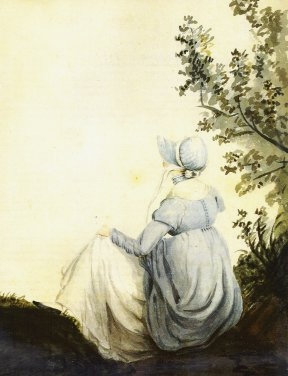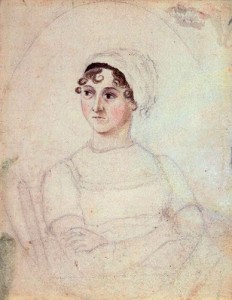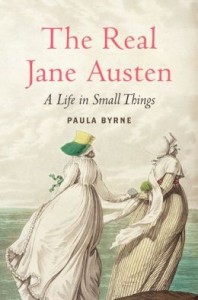Review of The Real Jane Austen: A Life in Small Things
In my book, Jane, Actually,1 one of the characters writes a biography with the title, The Real Jane Austen, that “examines the personality of Jane Austen with the tools of modern-day medicine, forensic psychiatry and textual analysis.” Fortunately, Paula Byrne’s The Real Jane Austen: A Life in Small Things, takes a far more relaxed and charming approach to telling Austen’s story.
Rather than starting with her birth and ending with her death, Byrnes focuses on objects—jewelry, paintings, notebooks, etc.—with which Austen might or might not have been familiar. All the objects were from Austen’s times and some were owned by Austen or her family. Some items are pedestrian: a card of lace similar to the lace Austen’s aunt was accused of stealing; and some are touching: an ad for the auction of household items from the Steventon parsonage; and some are calculating: a royalty check Jane received for sales of Emma.
The first item tells us that Jane lived in a world very different from us. Her Aunt Leigh-Perrot might have been executed or transported to Australia if convicted of the crime; and Mrs. Austen offered to send Jane and Cassandra as companions to her aunt while she was being held over for trial (in other words to stay with their aunt in jail).2 The second item hints at how much of a shock it must have been for Jane to leave Steventon for Bath after her father retired as rector. And the third reminds us that Jane was no naif when it came to business. She made some hard-headed business decisions and worked hard at developing her career and reputation (although in this instance, her decision to reprint Mansfield Park at the same time she was publishing Emma backfired).
 Byrne chooses several illustrations to tell her stories, including a watercolor of Lyme Regis, two paintings of sisters, another of a pair of women also shown on the book cover, and of course the sketch Byrne champions as being a representation of Austen drawn from life. It’s understandable that Byrne should include it—her husband gave it to her as a present, thinking it was an “imaginary portrait” (an idealized portrait). And she concludes the book (the epilogue) with another “portrait” of Austen. This watercolor, painted by Cassandra Austen, shows her sister from behind (seen right). Byrne calls it the only “irrefutably authentic image of the real Jane Austen.”
Byrne chooses several illustrations to tell her stories, including a watercolor of Lyme Regis, two paintings of sisters, another of a pair of women also shown on the book cover, and of course the sketch Byrne champions as being a representation of Austen drawn from life. It’s understandable that Byrne should include it—her husband gave it to her as a present, thinking it was an “imaginary portrait” (an idealized portrait). And she concludes the book (the epilogue) with another “portrait” of Austen. This watercolor, painted by Cassandra Austen, shows her sister from behind (seen right). Byrne calls it the only “irrefutably authentic image of the real Jane Austen.”
 I have to wonder at this last statement because the National Portrait Gallery seems to recognize that the unfinished pencil sketch/watercolor portrait seen left, also created by Cassandra, portrays Jane. I’ve also heard it called the only authentic image of Jane Austen. It doesn’t matter that many people dislike the image it offers of our favorite author.
I have to wonder at this last statement because the National Portrait Gallery seems to recognize that the unfinished pencil sketch/watercolor portrait seen left, also created by Cassandra, portrays Jane. I’ve also heard it called the only authentic image of Jane Austen. It doesn’t matter that many people dislike the image it offers of our favorite author.
I definitely would have included this portrait were I to write a biography told by objects. I’ve said several times in this blog how affected I was by seeing it in the National Portrait Gallery.
This oversight, however, is my only complaint about The Real Jane Austen, and I had to work hard to find it. You will probably not find anything that displeases in this delightful alternative to the traditional biography of Jane Austen, especially if like me you‘ve already read several such biographies. After all, there are few facts about Austen’s life that you don’t already know. The joy of The Real Jane Austen is discovering Jane through the context of the time in which she lived, without all the forensic psychiatry and textual analysis.

